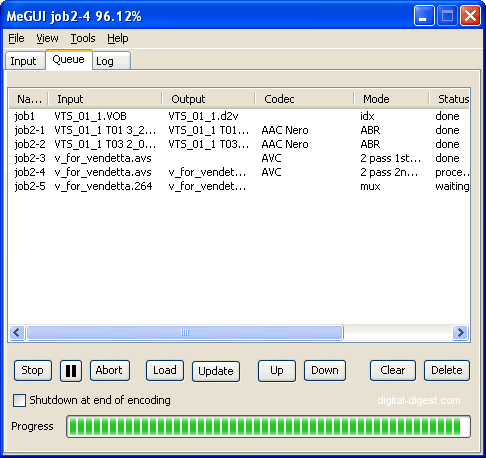MeGUI is one of the newer tools that has been designed with H.264 encoding in mind, while supporting other types of conversion, such as XviD. This guide shows you how to encode a H.264 (MP4) using MeGUI from a DVD as the primary example (instructions for converting other types of video files are also included).
This guide is aimed at intermediate users, basically users that are familiar with DVD conversion/backup and want to experiment with H.264 and MeGUI. As such, basic knowledge of DVD ripping and conversion is required, although brief instructions will be provided in any case.
Software you'll need (all freeware):


 Step 1: Installation
Step 1: Installation
 Step 2: DVD Ripping
Step 2: DVD Ripping
 Step 3: D2V Creator
Step 3: D2V Creator
This step will use MeGUI's D2V Creator tool to create a D2V file needed for MeGUI/AviSynth to handle MPEG-2 files. This step is required only for MPEG-2 files - all other types of inputs do not require a D2V file and can be loaded straight into AviSynth and therefore, you can skip this step and go to the next page/step (Step 4: AviSynth Script Creator).
Start MeGUI. I like to first clear the job queues of previously finished jobs. This is optional, but it might help to make things clearer. To do this, click on the "Queue" tab and then click on the "Clear" button.
From the "Tools" menu, select "D2V Creator". In the "Video Input" section, load the first ripped VOB file of the movie titleset (the rest of the files in the set will be loaded automatically). You will get an error message about not being able to find DVD Decrypter generated info files, this is fine (as we did not use DVD Decrypter's IFO mode) and
press "OK" to skip this error.
In RipIt4Me's step 1, you were asked to take note of the audio track numbers. We'll need it here select which audio track(s) to demux - you can select more than one track if you want the encoded file to have multiple audio tracks. Alternatively, you can just select the demux all the tracks and then choose the correct audio track(s) later on.
The default save directory is the same directory as your loaded DVD VOB files - change this if you want to.
Select both the "On completion load files", "and close" checkboxes and
press the "Queue" button. You are now returned to MeGUI -
click on the "Queue" tab and press the "Start" button to start the D2V creation. When processing has finished, the status of the queued job will read "Done" and the created D2V file will be loaded into the AviSynth Script Creator ready for the next step. This can take a while, so please be patient - the status window's progress bar may not move, but don't worry, DGIndex is working
 Step 4: AviSynth Script Creator
Step 4: AviSynth Script Creator
 Step 5a: Video Encoding Options MP4
Step 5a: Video Encoding Options MP4
We'll now set up the H.264 encoding options in the x264 encoder. This step has the most options to configure, and too many to cover in this guide alone. What I'll recommend is to use one of Sharktooth's profiles, and if you need further explanation of the options, refer to our
x264 Options Explained article.
In the MeGUI "Input" section, select "x264" as the "Codec" and "MP4" as the "Container".
For the "Video Profiles" option, select one of the x264 encoding profiles so we don't have to manually configure all the settings (unless you want to

, then click on the "Config" button to do so). A full explanation of what each profile is used for can be found on the
official forum thread for the profiles. For compatibility, I recommend using the CE profiles, particularly the "CE-QuickTime" profile (this will make the MP4 file playable in Apple QuickTime 7 or newer). The "CE-Baseline" profile is also fully QuickTime compatible, but uses less advanced features (and so will be faster during encoding at the expense of some quality).
 Step 5b: Video Encoding Options XVID
Step 5b: Video Encoding Options XVID
 Step 6: Audio Encoding Options
Step 6: Audio Encoding Options
 Step 7: AutoEncode and starting the encoding
Step 7: AutoEncode and starting the encoding
We're nearly finished. Press the "AutoEncode" button to launch the Automatic Encoder setup windows.
This is pretty straight forward - just specify the output size of your video file (and make sure the Container is set correctly, to "MP4" for the purpose of this guide). The output location can be changed as well - this file will be the final output file that you want, so make sure you remember where you put it and don't accidentally delete it when cleaning up (I like to put this file in a different folder to all the other files, just in case). Press the "Queue" button and all the necessary jobs will be added to the encoding queue.
Click on the "Queue" tab and all the jobs should be listed there. An explanation of the queued jobs shown in the screenshot below:
- job1: D2V Creation (already finished)
- job2-1: Encoding audio track 1
- job2-2: Encoding audio track 2
- job2-3: Encoding video, 1st pass
- job2-4: Encoding video, 2nd pass
- job2-5: Muxing audio and video to MP4

When you're ready to start, press the "Start" button to start the encoding and when it's all finished, your MP4 file should be ready. You can delete all the other files, unless you plan on making more encodings from them.
We're done

 MeGUI Custom x264/AVC video profiles. (Updated: 2006-12-21)
Url to this pages:
http://nade.dk/web/nade/site.nsf/FramesetHP?readform&wmain=files/Megui
MeGUI Custom x264/AVC video profiles. (Updated: 2006-12-21)
Url to this pages:
http://nade.dk/web/nade/site.nsf/FramesetHP?readform&wmain=files/Megui